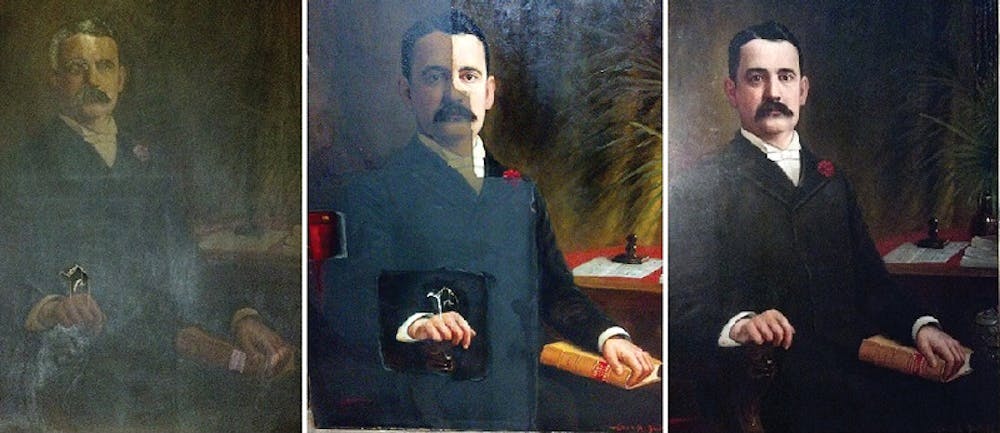From Samuel Bridgham 1794 to Joseph Paolino, Providence mayors are part of a long tradition of mayoral portraits.
Money raised through fundraising, private donations and grants over the past year have allowed for the restoration of 13 of these portraits, completing the collection of 32 artworks now on public display in City Hall.
Paul Campbell, Providence city archivist, said when he arrived in June 2010, one of the high priorities was to conserve and display these paintings so people could “enjoy and appreciate” them. He added that the collection is one of the most complete, continuous collections of any city in America, and the restoration has quickly picked up public interest. The paintings date as far back as the mid-1800s, but the two most recent mayors, Angel Taveras and John Lombardi, have not yet had their portraits made.
The restoration was completed by Alice Miles, a 1959 Rhode Island School of Design alum who has about 30 years experience in conserving paintings, Campbell said. She worked on the portraits in a temporary studio set up on the fifth floor of City Hall, which allowed people to come in and see the works in progress, ask questions and interact with the process, he said.
The conditions of the paintings varied, with some only needing light cleaning and others more extensive repair, Campbell said. The Elisha Dyer portrait, for example, had several large tears — “one story I heard was that a ladder had fallen through the canvas and severely damaged it,” he said. The portrait of Edwin McGuinness also underwent a significant transformation, Campbell said.
Miles said the experience of restoring the portraits was unique because the paintings were “so large.” The process began with an initial cleaning using a mild detergent to get the dirt off, followed by the use of a stronger element to remove the varnish. After a painting is clean, a layer of varnish is placed to separate the new touch-up painting from the original.
The repairing of patchwork is done behind the painting. “The canvas has a memory,” Miles said, and if the painting has been torn for a long time, it will be warped. She said one of the most challenging portraits was one in which the eye was poked out, and both the canvas and the eye had to be replaced with careful attention paid to matching the undamaged eye.
Mayors would often choose local artists to make their portraits, Miles said. “All these paintings were just beautifully painted,” she said.
The portrait collection “not only tells us a little bit about the men themselves who’ve served as mayor, but it also gives a chronology of some of the prominent artists who lived in the city and produced works,” Campbell said. He added that it “gives us an appreciation of the artists and their workmanship over nearly two centuries here in Providence.” Campbell is currently working on producing small biographical sketches of each mayor to be placed adjacent to each painting, he said.
“Realistic portraits of significant leaders date all the way back to classic times,” said Douglas Nickel, professor of history of art and architecture. Before the 19th century, portraiture was reserved for aristocratic people, he said, and in the earlier part of the 19th century, the attention remained focused on the sitter and not on the artist.
But in the late 1800s and early 1900s, society’s attitudes toward artists began to change, Nickel said, adding that they came to be seen as “interesting, expressive, special people themselves.” Around that time, there also developed a greater interest in the person being painted, and rather than just trying to capture what they looked like, portraitists would try to capture some of their “personality, character,” he said, adding that Providence was one of the major art capitals in the 19th century.
Councilman Terrence Hassett said the project was a “huge success” and described the archives as “one of the most sophisticated in the country.”

ADVERTISEMENT




